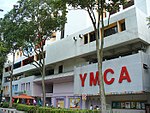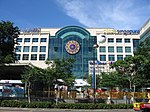Orchard Road Presbyterian Church
19th-century Presbyterian churchesChurches completed in 1878Churches in SingaporePresbyterian churches in Singapore

The Orchard Road Presbyterian Church (ORPC), also known as Greja Kechil ("small church" in Malay) and the Scotch Church, is a Presbyterian church in Singapore. The church was completed in 1878, and it is the oldest Presbyterian church in Singapore. The church was founded to serve the Scottish community in Singapore, but now caters to a congregation of a widely different background and holds services in a number of different languages.
Excerpt from the Wikipedia article Orchard Road Presbyterian Church (License: CC BY-SA 3.0, Authors, Images).Orchard Road Presbyterian Church
Orchard Road, Singapore Museum
Geographical coordinates (GPS) Address External links Nearby Places Show on map
Geographical coordinates (GPS)
| Latitude | Longitude |
|---|---|
| N 1.2980277777778 ° | E 103.84747222222 ° |
Address
Orchard Road Presbyterian Church
Orchard Road 3
238825 Singapore, Museum
Singapore
Open on Google Maps









